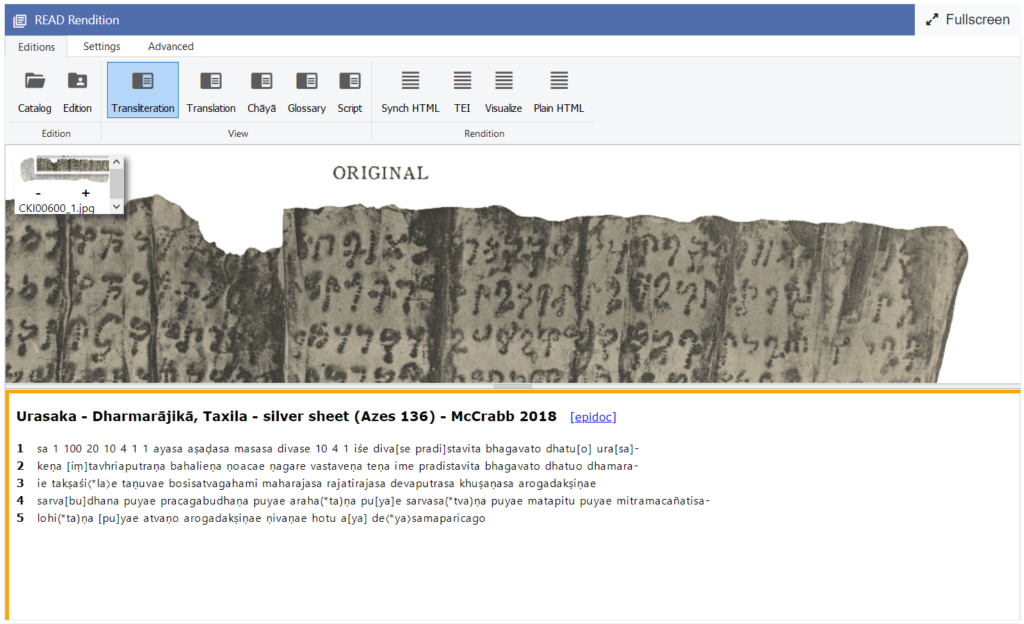This Buddha statue is currently part of the Kimbell Art Museum collection in Fort Worth, Texas (AP 1986.06). The exact provenance of the image is not recorded, but the use of red sandstone suggests it is from Mathurā. The image is a Kapardin Buddha type represented as sitting cross-legged on a lion throne, the left hand resting on the left leg and right hand raised in the vyāvr̥tta mudra, flanked by attendants, surrounded by a halo, and having a top-knot of hair (kapardin) covered in a cloth (uṣṇīṣa). The kapardin hair-bun and upper half of the halo is missing from this statue.
Conventional Name Kimbell Buddha | Findspot Mathura | Item Red Sandstone | Dimensions Height:93 Width:85.4 Depth: 16 | Date Kuṣāṇa 4 (=131 CE) | Collection | Current Location Kimbell Art Museum, Fort Worth, Texas – AP 1986.06 | Language/Script EHS/Brāhmī
Content Summary
On the twenty-sixth day of the third rainy month in the forth year Kaniṣka I (=131 CE), the honorable Dharmanandin, a co-resident of the monk Bodhisena, established this Bodhisattva in his own sanctuary together with his parents, paternal aunt Bhadrā, and all beings.
Keywords
Benefit, Buddha, Donation, EraRulerDate
Previous Editions
-
Fussman, Gérard. 1988. “Documents Épigraphiques Kouchans (V): Buddha and Bodhisattva dans l’Art de Matura: Deux Bodhisattvas Inscrits de l’An 4 et l’An 8.” Bulletin de l’École française d’Extrême-Orient, 77: 5-26.
Other References
-
Härtel, Herbert. 1995. “A Remarkable Inscribed Sculpture from Mathura.” In John Guy, ed., Indian Art and Connoisseurship: Essays in Honour of Douglas Barrett, pp. 32-43. Ahmedabad, India : Indira Gandhi National Centre for the Arts in association with Mapin Publishing.
Acknowledgements
Research on this edition and production of the digital edition was completed with in kind support of the Prakaś Foundation.
Digital publishing by Michael Skinner
Each digital edition includes background information about the text, a summary of its content, and references to parallel texts and related publications. Users can explore the text, image, and other analysis resources through various preset views from the READ interface, or customize the views themselves.
By developing the text in READ, the text and image are linked such that selecting a syllable, word, or compound in the text or glossary will highlight the associated akṣaras on the manuscript. This allows you to in effect “read” the manuscript as you read the transcribed text, even if you do not know the script.
Users can choose from several preset READ views by selecting the tabs at the top. Each of these convenient arrangements of text and resources is suited to a different experience with the manuscript. For instance, choose the Script view to study the paleography of the manuscript or the Glossary view to study its vocabulary. It is recommended that the user toggles through the default views to gain a holistic perspective of the text.

- Transliteration: Image and transliteration.
- Translation: Transliteration and translation.
- Chāyā: Transliteration and chāyā.
- Glossary: Image, transliteration, and glossary.
- Script: Image, transliteration, and script chart
- Visualize: Visualize the text structure display.
- Synch HTML: Interactive synchronized rendition.
- TEI: EpiDoc TEI rendition.
- Plain HTML: Transliteration in HTML format.
Avś
Be
Ce
Ch.
CPS
DhG
Ee
FJJ
Mahīś
MūSā
Mvu
P
SĀ
SBhV
Se
Skt.
SN
T
Tib.
Vin
Avadānaśataka (ed. Speyer 1906–1909)
Burmese (Chaṭṭhasaṅgāyana) edition
Sri Lankan (Buddha Jayanti Tipiṭaka Series) edition
Chinese
Catuṣpariṣat-sūtra (ed. Waldschmidt 1952–1962)
Dharmaguptaka
European (Pali Text Society) edition
Fobenxing ji jing (T 190)
Mahīśāsaka
Mūlasarvāstivāda
Mahāvastu-avadāna (ed. Senart 1882–1897)
Pali
Saṃyukta-āgama (T 99)
Saṅghabhedavastu (ed. Gnoli 1977–1978)
Thai (King of Siam) edition
Sanskrit
Saṃyutta-nikāya
Taishō 大正 edition
Tibetan
Vinaya

